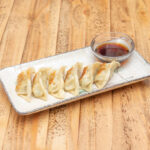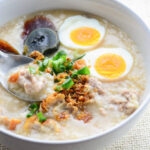French Japanese fusion is a culinary style that combines the flavors, techniques, and ingredients of French and Japanese cuisine. This unique fusion emerged in the late 20th century as chefs began experimenting with blending the delicate flavors and presentation of Japanese cooking with the rich and complex flavors of French cuisine. The result is a harmonious balance of flavors, textures, and aesthetics that showcases the creativity and skill of chefs who are passionate about combining these two distinct culinary traditions. French Japanese fusion has gained popularity worldwide, offering a delightful dining experience that appeal to both French and Japanese food enthusiasts.
| Ingredients | |
| 1 | 4 codelets |
| 2 | 4 tablespoons miso paste |
| 3 | 2 tablespoons Mir (Japanese sweet rice wine) |
| 4 | 2 tablespoons soy sauce- 2 tablespoons honey |
| 5 | 1 tablespoon vegetable oil |
| 6 | the Ratatouille: |
| 7 | 1 eggplant, diced |
| 8 | 1 zucchini, diced |
| 9 | 1 red bell pepper, diced |
| 10 | 1 yellow bell pepper, diced |
| 11 | 1 onion, diced |
| 12 | 3 cloves garlic, minced |
| 13 | 2 tomatoes, diced |
| 4 | 2 tablespoons olive oil |
| 15 | Salt and pepper to taste |
Step-by-step cooking instruction of French Japanese Fusion:
Step-1 In a small bowl, mix together the miso paste, mirin, soy sauce, and honey until well combined.
Step-2 Place the cod fillets in a shallow dish and pour the miso marinade over them. Make sure all sides are coated. Place it in the fridge to marinate for at least half an hour.
Step-3 Preheat your oven to 400°F (200°C).
Step-4 Heat vegetable oil in an oven-safe skillet over medium-high heat. Remove the cod fillets from the marinade and sear them on each side for about 2 minutes until they develop a golden crust.
Step-5 Transfer the skillet to the preheated oven and bake for about 10 minutes or until the fish is cooked through and flakes easily with a fork.
Step-6 While the cod is baking, prepare the ratatouille. In a different skillet, warm up the olive oil over medium heat. When aromatic, add the onions and garlic and sauté.
Step-7 Add the diced eggplant, zucchini, and bell peppers to the pan. Sauté them for around five minutes, or until they begin to soften.
Step-8 Add the diced tomatoes and season with salt and pepper. Cook until all the vegetables are soft, about 5 to 7 more minutes.
Step-9 Serve the miso-glazed cod on a plate with a generous portion of ratatouille on the side.
Nutritional values of French Japanese Fusion:
The nutrition values of French Japanese fusion dishes can vary depending on the specific ingredients and cooking methods used. Nonetheless, the following provides a broad summary of the possible nutritional advantages:
| 1 | Protein: French Japanese fusion often incorporates seafood like cod or salmon, which are excellent sources of lean protein. Protein is necessary for immune system support, tissue growth and repair, and energy production. |
| 2 | Omega-3 Fatty Acids: Seafood commonly used in French Japanese fusion dishes, such as salmon or tuna, are rich in omega-3 fatty acids. Numerous health advantages, such as lowering inflammation, strengthening heart health, and promoting brain function, have been connected to these good fats. |
| 3 | Vegetables: French Japanese fusion often includes a variety of vegetables like eggplant, zucchini, bell peppers, and tomatoes. These vegetables are low in calories and high in vitamins (such as vitamin C and vitamin A), minerals (such as potassium), and dietary fiber. They provide essential nutrients while adding color, flavor, and texture to the dish. |
| 4 | Probiotics: Miso paste, a common ingredient in Japanese cuisine, is made from fermented soybeans. It contains beneficial bacteria that can support gut health by promoting a healthy balance of gut flora. |
| 5 | Sodium: Some ingredients used in French Japanese fusion dishes, like miso paste or soy sauce, can be high in sodium. It’s important to moderate your intake of these ingredients if you’re watching your sodium levels. |
| 6 | Healthy Cooking Methods: French Japanese fusion often incorporates healthier cooking methods like grilling or baking rather than deep-frying. This helps to retain the nutritional value of the ingredients while minimizing added fats. |
Background History of French Japanese Fusion:
French Japanese fusion cuisine, also known as Franco-Japanese cuisine or Japonaiserie, is a culinary style that combines elements of French and Japanese cooking techniques, ingredients, and flavors. The fusion of these two cuisines emerged in the late 20th century and has gained popularity worldwide.
The origins of French Japanese fusion can be traced back to the 1970s when Japanese chefs began incorporating French culinary techniques into their traditional Japanese dishes. This was influenced by the increasing interest in French cuisine among the Japanese population at that time. Many Japanese chefs traveled to France to study French cooking methods and bring back their knowledge to Japan.
At the same time, French chefs started experimenting with incorporating Japanese ingredients and flavors into their dishes. This was partly due to the growing popularity of sushi and other Japanese foods in France during the 1980s.
The fusion of French and Japanese cuisines gained significant attention in the 1990s when renowned chefs like Nobu Matsuhisa and Tetsuya Wakuda opened restaurants that showcased this unique culinary style. Their innovative approach to blending French and Japanese flavors attracted international acclaim and sparked a trend in fusion cuisine.
French Japanese fusion cuisine combines the precision and technique of French cooking with the delicate flavors and presentation of Japanese cuisine. It often features a balance of rich sauces, butter, and cream from French cuisine with lighter ingredients like seafood, vegetables, and soy-based seasonings from Japanese cuisine.
This culinary fusion has resulted in dishes such as miso-marinated foie gras, sushi rolls filled with foie gras or truffles, tempura-style vegetables served with aioli sauce, or classic French desserts infused with matcha (green tea) or yuzu (citrus fruit) flavors.
Today, French Japanese fusion cuisine continues to evolve as chefs experiment with new combinations of ingredients and techniques. It has become a popular trend not only in high-end restaurants but also in casual dining establishments around the world, showing the harmonious blend of two distinct culinary traditions.
| Advantages of French Japanese Fusion | |
| 1 | Unique Flavor Combinations: French Japanese fusion cuisine offers a unique and exciting blend of flavors by combining the rich, creamy, and savory elements of French cuisine with the delicate, umami-rich flavors of Japanese cuisine. This fusion can create unexpected and delicious taste experiences. |
| 2 | Culinary Innovation: French Japanese fusion allows for culinary creativity and innovation. Chefs can experiment with new ingredient combinations, cooking techniques, and presentation styles to create dishes that are visually stunning and gastronomically intriguing. |
| 3 | Nutritional Balance: The fusion of French and Japanese cuisines often results in dishes that offer a balance of proteins, vegetables, and healthy fats. This can provide a well-rounded nutritional profile, incorporating lean proteins from seafood or lean meats, nutrient-dense vegetables, and healthy fats from sources like fish or avocado. |
| 4 | Cultural Exchange: French Japanese fusion cuisine represents a cultural exchange between two distinct culinary traditions. It allows for the appreciation and integration of different ingredients, techniques, and food philosophies from both cultures. |
| Disadvantages of French Japanese Fusion | |
| 1 | Authenticity Concerns: Some purists may argue that French Japanese fusion dilutes the authenticity of both cuisines. Critics may feel that blending two distinct culinary traditions can result in dishes that lack the true essence or integrity of either cuisine. |
| 2 | Ingredient Availability: Some ingredients used in French Japanese fusion dishes may not be readily available in all regions or may be expensive to source. This can limit accessibility for home cooks or restaurants outside major metropolitan areas. |
| 3 | Complexity: The fusion of two complex culinary traditions can result in intricate recipes that require advanced cooking skills or specialized equipment. This complexity may make it challenging for novice cooks to recreate these dishes at home. |
| 4 | Potential Overuse of Rich Ingredients: French cuisine is known for its use of butter, cream, and rich sauces, while Japanese cuisine tends to focus on lighter flavors and healthier cooking methods. In some cases, French Japanese fusion dishes may lean heavily on rich ingredients, which can lead to higher calorie and fat content. |
Compare with Similar meal French Japanese Fusion:
Similar meals to French Japanese fusion can be found in other types of fusion cuisine that combine elements of French and Japanese cooking. Here are a few examples:
| 1 | California Roll: This popular sushi roll is a fusion of Japanese and American cuisine. Usually, rice and seaweed are used to wrap crab meat, avocado, and cucumber. The addition of avocado is influenced by the use of creamy ingredients in French cuisine. |
| 2 | Tempura-style Seafood with Aioli Sauce: Tempura is a Japanese cooking technique where seafood or vegetables are lightly battered and deep-fried. In French Japanese fusion, this dish may be served with aioli sauce, which is a garlic-flavored mayonnaise commonly used in Mediterranean cuisine. |
| 3 | Miso-Marinated Grilled Fish: This dish combines the traditional Japanese technique of marinating fish in miso paste with the French method of grilling. The miso marinade adds depth of flavor to the fish while grilling gives it a smoky char. |
| 4 | Matcha-infused Desserts: Matcha, a powdered green tea, is often used in both traditional Japanese desserts and French pastries. French Japanese fusion may incorporate matcha into desserts like macarons, cakes, or ice cream to add a unique flavor profile. |
| 5 | Foie Gras Sushi: Foie gras, a delicacy made from duck or goose liver, is commonly associated with French cuisine. In fusion dishes, foie gras may be incorporated into sushi rolls or nigiri for a luxurious twist on traditional sushi. |
| 6 | Yuzu-infused Sauces: Yuzu is a citrus fruit commonly used in Japanese cuisine for its tangy and aromatic flavor. In French Japanese fusion, yuzu juice or zest may be added to sauces like beurre blanc (a classic French butter sauce) to give them a bright and refreshing twist. |
Mostly questions asked about French Japanese Fusion
1: What is French Japanese fusion cuisine?
A: French Japanese fusion cuisine is a culinary style that combines elements of French and Japanese cooking techniques, ingredients, and flavors. It emerged in the late 20th century and has gained popularity worldwide.
2: How did French Japanese fusion cuisine originate?
A: The fusion of French and Japanese cuisines began in the 1970s when Japanese chefs started incorporating French culinary techniques into their traditional dishes. At the same time, French chefs began experimenting with Japanese ingredients and flavors.
3: What are some popular dishes in French Japanese fusion cuisine?
A: Popular dishes in French Japanese fusion cuisine include miso-marinated foie gras, sushi rolls filled with foie gras or truffles, tempura-style vegetables served with aioli sauce, and classic French desserts infused with matcha or yuzu flavors.
4: What are the advantages of French Japanese fusion cuisine?
A: Advantages of French Japanese fusion cuisine include unique flavor combinations, culinary innovation, nutritional balance, and cultural exchange between two distinct culinary traditions.
5: Are there any disadvantages to French Japanese fusion cuisine?
A: Disadvantages of French Japanese fusion cuisine can include concerns about authenticity, ingredient availability, complexity of recipes, and potential overuse of rich ingredients.
6: Can I recreate French Japanese fusion dishes at home?
A: Yes, you can recreate French Japanese fusion dishes at home with some practice and access to the necessary ingredients. There are many recipes available online that provide step-by-step instructions for preparing these dishes.
7: Where can I find restaurants that serve French Japanese fusion cuisine?
A: French Japanese fusion cuisine can be found in high-end restaurants specializing in this style of cooking. It has also become a popular trend in casual dining establishments around the world.
8: Is French Japanese fusion cuisine healthy?
A: French Japanese fusion cuisine can be healthy if it incorporates a balance of proteins, vegetables, and healthy fats. However, some dishes may lean towards richer ingredients like butter and cream, so it’s important to consider portion sizes and overall dietary balance.
9: Can I substitute ingredients in French Japanese fusion recipes?
A: Yes, you can substitute ingredients in French Japanese fusion recipes based on your preferences or ingredient availability. However, keep in mind that certain ingredients contribute to the unique flavor profile of these dishes, so substitutions may alter the final result.
10: Are there any other types of fusion cuisine similar to French Japanese fusion?
A: Yes, there are other types of fusion cuisine that combine elements of French and Japanese cooking with other culinary traditions. Examples include Vietnamese-French fusion (known as “Franco-Vietnamese”) and Korean-French fusion (known as “Koreanaise”).







